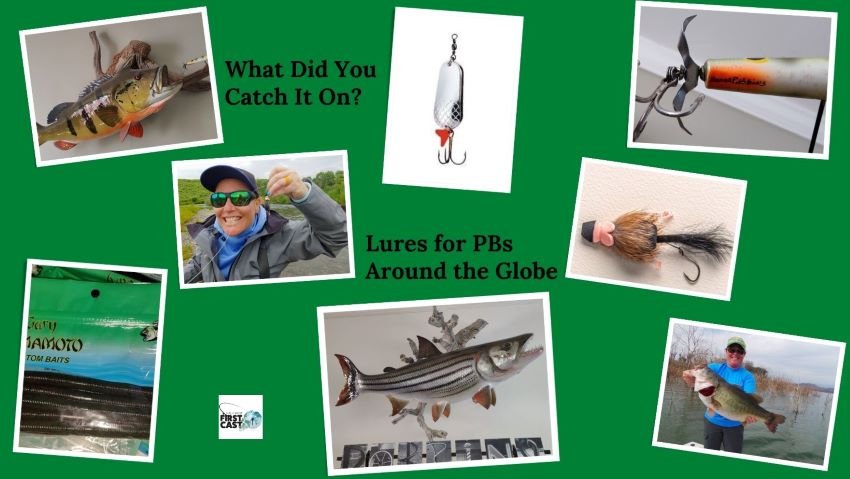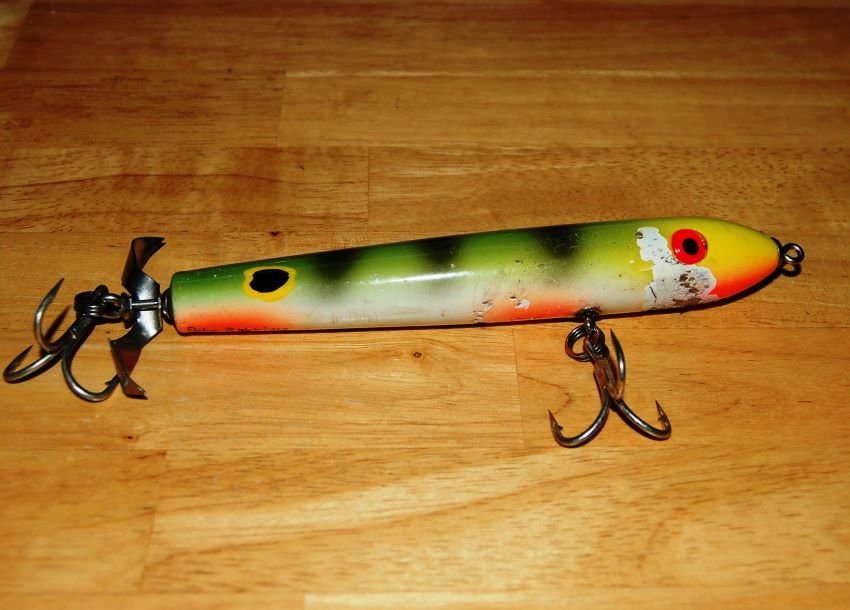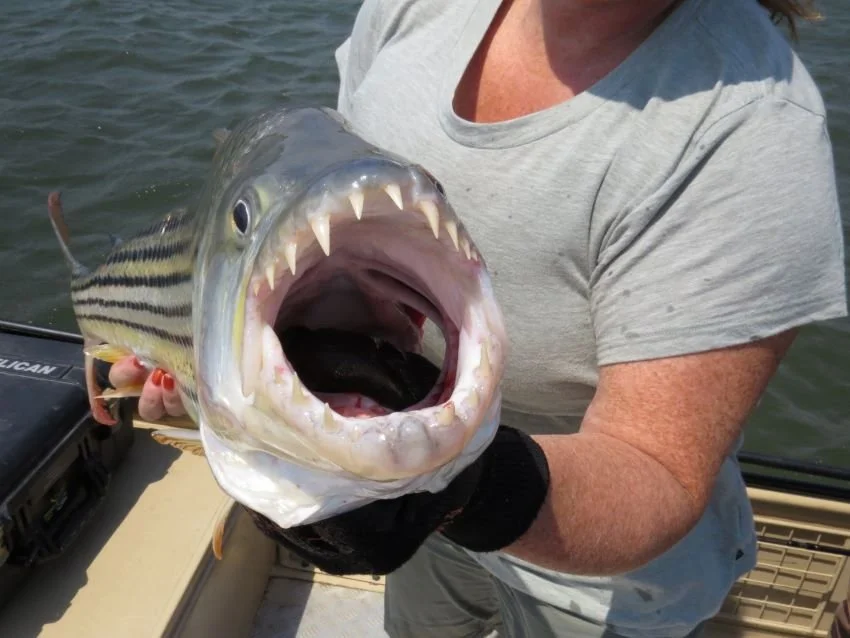What Did You Catch It On? Lures for PBs Around the Globe
Post a picture of an impressive fish on Facebook or Instagram and you’re likely to get two questions: “How big was it?” and “What did you catch it on?”
Living with and being taught by Pete Robbins, I have become a non-diagnosed OCD angler. When we fish, we always have a scale and a tape measure. Although this may seem like a good way to jinx ourselves – the same rationale for why I don’t wear the saltwater fighting belt until a fish either rises or is hooked, and why the net is always put away after we catch a fish, at least they are not out but tucked away, they are always in the same place so that we both can get to them easily.
It's worked so far. I’ve been fortunate enough to catch trophy fish across the globe. Now, to answer your question of what I caught them on, here are the specific lures:
BRAZIL – K Lures Peacock Ripper
My first true “exotic” trophy, which resulted in my first replica, was my 19-pound Acu Peacock Bass, caught in the Brazilian Amazon.
Before our first trip to the Amazon in 2011, Pete contacted lure maker Kermett Adams and ordered a selection of topwater prop baits. They’re torpedo-shaped a prop on the end, sometimes two. They are an absolute bear to use. You cast it out and rip it hard back to the boat. The sound of the propeller and the rip of the bait through the water brings the fish up to the surface to eat.
Tip: If the fish misses the first time, DON’T STOP, keep ripping. A lot of time the second or even the third hit is the deal.
These lures are literally pieces of art and Kermett sent one with Pete’s name inscribed on it. I was hesitant to use them, especially the one with Pete’s name on it in case, well you know how it goes -- best lure often equals lost lure.
I can picture the surroundings, although couldn’t ever get you back to the exact same spot, as everything in the Amazon looks the same yet different. The fish exploded on the K Lure. “Do not lose the bait,” I reminded myself. The fish made a beeline for something that looked like a cave and I thought, “I need to get it out of there.” I reeled fast and the guide said, “Relax. Let the fish get tired.” Then the peacock took off again. That went on for a while but as long as he didn’t jump and I kept him down, I was sure I would eventually get him to the boat. The fish tired out and Hanna won. Although the fish looks humongous, keep in mind that both the guide and I are both under 5’2” tall. The fish was only 19 pounds.
What could be terrible about catching a huge, beautiful, peacock bass on a topwater? Catching it on a lure with your husband’s name on it! Well so be it, I caught the fish and he didn’t.
Upon our arrival home, Pete contacted Advanced Taxidermy, to get both of our personal best peacocks mounted (I refuse to say how big his was). The taxidermy process takes a long, long time and during this time Pete, unbeknownst to me, contacted Kermett and asked him to take his name off the lure and replace it with mine. Then Pete sent it to Advanced to have it incorporated in my mount.
Did I ever tell you I have the best husband?
AFRICA – Effzett Spoon
When you first walk into our home, you’re immediately greeted by our fireplace smack dab in the middle of the living room. Most people have a picture of their family, a nice mirror, a painting or a television in that spot. Not the Robbins family: we have the tigerfish fish I caught on the Zambezi River in Africa.
I have traveled all over the world, but my clear-cut favorite trip of all time was our 2016 excursion to Africa with guide and friend Uncle Steve Yatomi of Adventure Travel Alliance.
Our accommodations at The Hide, Chiawa Camp and Old Mondoro were beyond luxurious, despite being situated in the middle of the nowhere. Every day it got better. We saw 53 lions (unheard of). We were in the right spot at the right time to observing a lion kill and devour a water buffalo from start to finish. From the standpoint of rarity, we were amazed to see a pack of wild painted dogs. That was beyond lucky as there are fewer than 7,000 left across the entire continent. Finally, we were lucky to avoid getting swallowed by a hippo, the most dangerous animal in Africa (I have a fishing story for that).
But the Robbins family can’t go any place without making sure we get at least a few days of fishing in. That would be silly.
The Zambezi River is the fourth largest river in Africa and the fishermen that visit there go to battle the tigerfish. Imagine crossing a shark with a piranha, that’s what they’re like. They are extremely aggressive and have razor-sharp teeth. They can weigh as much as 30 pounds, but a good catch is one between 12 and 18 pounds.
We were warned that catching tigerfish wasn’t going to be easy. Their razor-sharp teeth can easily cut the line, their mouths are ridiculously hard and it’s very hard to hookset into them, they jump and unlike bass fishing you need to pull up once the fish hits your bait.
So, you may be thinking, “Why bother? Go look for animals and take pictures of birds.” Hell no, the perceived difficulty level wasn’t going to stop us from giving this a shot. Uncle Steve came equipped with these crazy looking double Effzett Spoons by DAM. At the time I had no idea what they were but I now actually fish with a similar Strike King bait in Mexico. We mostly retrieved it like a spinnerbait or a swim jig as the current was very heavy. When you felt a bite, you needed to lift hard and jam that hook into the roof of their mouth. They have an extremely hard, double-jointed jaw so if they are hooked on the side of the mouth and they open up too far, the hook would come loose.
I was a real pro -- not kidding. I followed directions and caught a lot of dinks but still caught what most people strive for – plenty of quality tigers -- and then I hooked into the one we came for. It was amazing that we even got it in the boat, as the net had a huge hole, but our super-duper guide Clement Zomba got it back through the hole and up onto the boat. As excited as I was, Clement was giddy. On the Boga Grip this fish weighed 14.5 pounds and it was the largest tigerfish anyone caught at Chiawa Camp that season. He was the guide that found the fish for us.
We took a million pictures, weighed it, measured it and then released it, like all the rest of the fish we caught. My name was on the Chiawa Camp brag board and in my head it’s still there. Yay me!
ALASKA – Rio’s Pip Squeak
If you haven’t been to the “Last Frontier,” you need to go soon. If you’ve already been, you need to go again.
My first fly fishing attempt was in Montana, at Triple Creek Ranch, as we fished with our guide Steve Grant down the Bitterroot River. Even if you don’t fish you should figure out how to take a boat ride down the Bitterroot, magnificent scenery. Steve was a great guide, but he put the fear of God in me. He said there are only three things you need to know while fishing in my boat: (1) “Arm pit, arm pit, arm pit”; (2) Don’t dangle the fly in front of Pako, his dog that sat next to me the entire day; and (3) don’t hook Pako. That made me both nervous and careful, fearing that I was going to get strangled by the line. That didn’t happen – we caught fish and as far as I know Pako has no more bodily holes than before.
I didn’t fly fish again until I visited Alaska five years later. Just like riding a bike after a little refresher we had no problem putting 50 pounds of sockeye salmon in the freezer.
Arm pit, arm pit, arm pit. Mend the line. Keep the line as tight as possible with no drag. This helps you set the hook when the fish strikes (the one similarity to bass fishing).
For some reason I find fly fishing tackle much more interesting than bass tackle. The flies are furry, and most are little, colorful and dainty. I’m such a girl. Most of the trip we used a bead that imitated salmon eggs, and also a few streamers one of which was an egg sucking leech.
And then Reuben Hastings, our guide and now friend, did a very bad thing, he opened his fly box in front of me (that sounds awful, but that’s what happened) and I saw the cutest fly – Rio’s Pip Squeak. It looked just like a mouse with little legs that kick. IF you present it correctly the fly simulates a live mouse moving through the water.
I am by no means an expert fisherman. I can get the job done but this got my competitive juices flowing. I so wanted to try to catch a fish on the mouse. Reuben rolled his eyes but smiled and giggled and he knew I wasn’t going to let this day end without me at least trying. Fishing the mouse is much different than fishing a bead. You cast the fly out, and you need to wiggle the rod tip and collect your slack line to keep the fly moving as if it was a real mouse doing the breast stroke down the creek. It’s easy to write but much more difficult to achieve. I was determined. I wanted to catch a fish on the mouse so I could get a picture to prove I had caught one and I did. And for the rest of the day me and my mouse (no, I did not have a mouse in my pocket) caught rainbow trout and grayling, one after another.
I messaged Reuben the other day and he said, “You made my day sticking to your guns working that mouse.” It’s the little things – hehehe, pun intended. I didn’t catch any giants that day, but the fact I figured out a difficult technique and caught plenty of fish is a win in my book.
MEXICO – Yamamoto Senko
I’ve been to Anglers Inn over 20 times and I have still not caught a 10-pounder. I don’t know, maybe I want it too badly? Perhaps I have the camera in my hand when I should be fishing? Maybe I’m talking too much (That’s the Pete Robbins theory).
But what I have done is caught seven fish that pushed the scale past 9 pounds! So my failure to land a 10 (so far) is truly a first-world problem.
With so many baits to choose from especially when you travel with tackle junkie Pete Robbins (second only to Kevin “The Baitman” Baxter), I try to keep it simple. There’s good reason for that: Two of my heaviest 9-plus-pounders were caught on a 6-inch green pumpkin Senko, on the same day on two different lakes.
In the morning I was fishing solo with my guide Armando. No net, no scale, which makes for a better story, I guess. I remember the end of the bluff, and I also recall that it wasn’t my first cast at the same spot. Then I felt it, I set the hook, and it was just heavy. Armando, who is incredibly quiet and reserved, got a little excited. He broke out some of his English: “Big fish. Grande.” He was right but how would we really know without an accurate weight? Fortunately he knew another guide was around the corner with two other anglers. We hurried over, in order to make sure we didn’t harm the fish, and thank goodness those guys had a scale. Nine pounds five ounces and high fives all around.
Later that afternoon Pete and I journeyed over to what is now the Anglers Inn Lake Picachos location, to check it out, learn Billy Chapman Jr.’s plans, and get a little fishing time in. Pete and I only fished a few hours with one rod apiece and a stash of Senkos. At one point, we tied up to one area and caught 72 fish in no time. If one fish dropped the lure another would pick it up.
I caught a fish and Pete set his rod down, leaving the bait in the water, to help get my fish in and the next thing we knew his rod handle was bobbing in the water under the tension from another fish. These fish were so hungry.
Then I caught something I knew was a little bigger but when it came to the surface, on its side, with a huge bulging eye, Pete put his rod down again, this time keeping everything inside the boat, and started saying, “Twelve pounder, that’s a 12 pounder!” It was as if time stopped, I don’t remember anything but the picture in my head, still to this day, of the fish laying on its side in the water, I guess I was so excited that I could have caught a fish of a lifetime that my mind went blank.
Short and stout, like the girl who caught her, she only weighed 9-12. I wish I weighed less than I look, too. It was still an amazing fish, an amazing memory and an amazing story -- in one day, on two different lakes, the Senko was the prize bait for two fish well over 9 pounds.
I know you are now thinking about “that time” when you caught “that huge fish” on “that bait.”
Everyone has a story, please tell me yours in the comments below or email us at fishmore@halfpastfirstcast.com.











